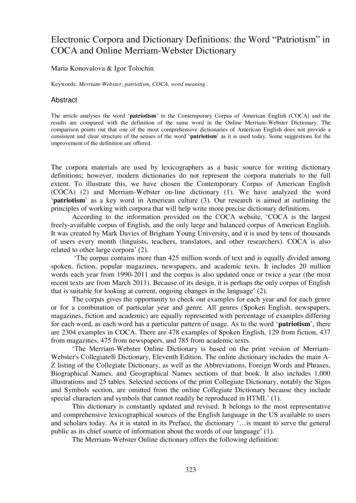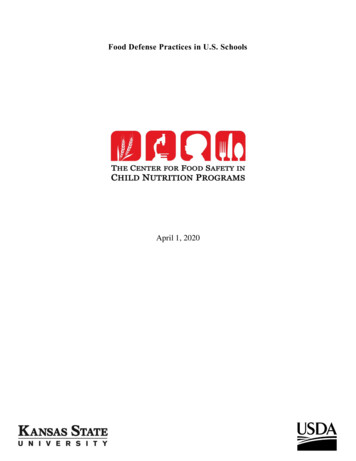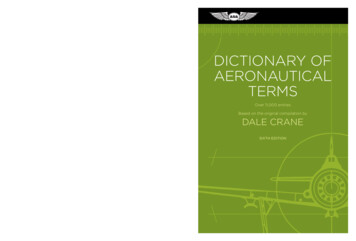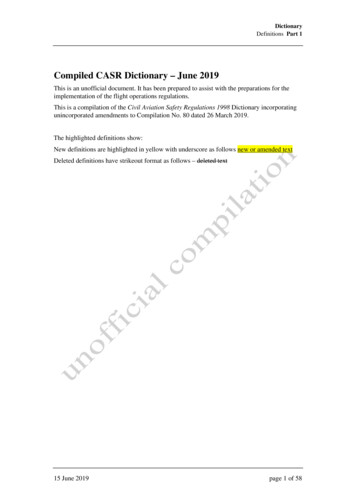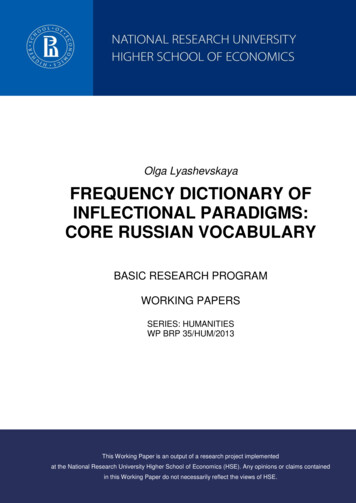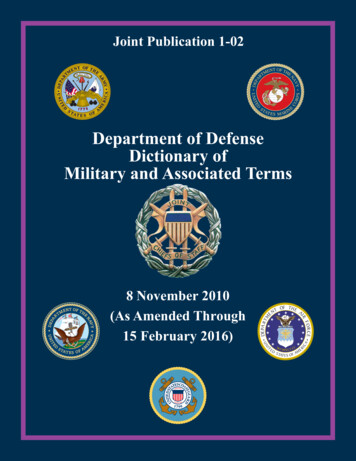
Transcription
Joint Publication 1-02Department of DefenseDictionary ofMilitary and Associated Terms8 November 2010(As Amended Through15 February 2016)
As Amended Through 15 February 2016PREFACE1.ScopeThe Joint Publication (JP) 1-02, Department of Defense Dictionary of Military and AssociatedTerms, sets forth standard US military and associated terminology to encompass the joint activity ofthe Armed Forces of the United States. These military and associated terms, together with theirdefinitions, constitute approved Department of Defense (DOD) terminology for general use by allDOD components.2.PurposeThis publication supplements standard English-language dictionaries and standardizes militaryand associated terminology to improve communication and mutual understanding within DOD, withother federal agencies, and among the United States and its allies.3.ApplicationThis publication applies to the Office of the Secretary of Defense, the Services, the Joint Staff,combatant commands, DOD agencies, and all other DOD components. It is the primary terminologysource when preparing correspondence, to include policy, strategy, doctrine, and planning documents.Criteria for inclusion of terminology in JP 1-02 is enumerated in Department of Defense Instruction5025.12, Standardization of Military and Associated Terminology, and Chairman of the Joint Chiefsof Staff Instruction (CJCSI) 5705.01, Standardization of Military and Associated Terminology.4.Publication FormatThis edition of JP 1-02 has been published in two basic parts:a. Terms and definitions. These are annotated with the source publication.b. Abbreviations and acronyms. The source publication establishes the authoritative contextfor proper understanding and management of the associated term.5.JP 1-02 Online Availability and Update ScheduleJP 1-02 is accessible online as a searchable database and in PDF format at the following Internetaddress:http://www.dtic.mil/doctrine/dod dictionary and at the following NIPRNETi
PrefaceAs Amended Through 15 February 2016address: https://jdeis.js.mil/jdeis/. The contents of JP 1-02 are updated on a monthly basis to includeany terminology additions, modifications, or deletions made within the previous calendar month inaccordance with CJCSI 5705.01.For the Chairman of the Joint Chiefs of Staff:WILLIAM E. GORTNEYVice Admiral, USNDirector, Joint StaffiiJP 1-02
TABLE OF CONTENTSMAIN BODY . . 1APPENDIXAAbbreviations and Acronyms . A-1BAdministrative Instructions . B-1iii
Table of ContentsIntentionally BlankivJP 1-02
As Amended Through 15 February 2016Aacceptability — The joint operation plan review criterion for assessing whether thecontemplated course of action is proportional, worth the cost, consistent with the law of war;and is militarily and politically supportable. See also adequacy; feasibility. (JP 5-0)access — In counterintelligence and intelligence use, a. a way or means of approach toidentify a target; or b. exploitable proximity to or ability to approach an individual,facility, or information that enables target to carry out the intended mission. (JP 2-01.2)access to classified information — The ability and opportunity to obtain knowledge ofclassified information by persons with the proper security clearance and a need to knowof specified classified information. (JP 2-01)accompanying supplies — Unit supplies that deploy with forces. (JP 4-01.5)accountability — The obligation imposed by law or lawful order or regulation on an officeror other person for keeping accurate record of property, documents, or funds. (JP 1)acoustic intelligence — Intelligence derived from the collection and processing of acousticphenomena. Also called ACINT. (JP 2-0)acquisition and cross-servicing agreement — Agreement, negotiated on a bilateral basiswith United States allies or coalition partners, that allow United States forces to exchangemost common types of support, including food, fuel, transportation, ammunition, andequipment. Also called ACSA. See also cross-servicing. (JP 4-08)actionable intelligence — Intelligence information that is directly useful to customers forimmediate exploitation without having to go through the full intelligence productionprocess. (JP 2-01.2)action phase — In amphibious operations, the period of time between the arrival of thelanding forces of the amphibious force in the operational area and the accomplishmentof their mission. See also amphibious force; amphibious operation; landing force;mission. (JP 3-02)activation — Order to active duty (other than for training) in the federal service. See alsoactive duty; federal service. (JP 4-05)active air defense — Direct defensive action taken to destroy, nullify, or reduce theeffectiveness of hostile air and missile threats against friendly forces and assets. See alsoair defense. (JP 3-01)active defense — The employment of limited offensive action and counterattacks to deny acontested area or position to the enemy. See also passive defense. (JP 3-60)JP 1-021
As Amended Through 15 February 2016active duty — Full-time duty in the active military service of the United States, includingactive duty or full-time training duty in the Reserve Component. Also called AD. Seealso active duty for training; inactive duty training. (JP 4-05)active duty for special work — A tour of active duty for reserve personnel authorized frommilitary and reserve personnel appropriations for work on active or reserve componentprograms. Also called ADSW. (JP 1-0)active duty for training — A tour of active duty that is used for training members of theReserve Component to provide trained units and qualified persons to fill the needs of theArmed Forces in time of war or national emergency and such other times as the nationalsecurity requires. Also called ADT. (JP 4-05)Active Guard and Reserve — National Guard and Reserve members who are on voluntaryactive duty providing full-time support to National Guard, Reserve, and ActiveComponent organizations for the purpose of organizing, administering, recruiting,instructing, or training the Reserve Components. Also called AGR. (CJCSM 3150.13)activity — 1. A unit, organization, or installation performing a function or mission. 2. Afunction, mission, action, or collection of actions. Also called ACT. (JP 3-0)act of mercy — In personnel recovery, assistance rendered to evaders by an individual orelements of the local population who sympathize or empathize with the evaders’ causeor plight. See also evader; evasion; recovery; recovery operations. (JP 3-50)acute radiation dose — Total ionizing radiation dose received at one time and over a periodso short that biological recovery cannot occur. (JP 3-11)acute radiation syndrome — An acute illness caused by irradiation of the body by a high doseof penetrating radiation in a very short period of time. Also called ARS. (JP 3-11)Adaptive Planning and Execution system — A Department of Defense system of jointpolicies, processes, procedures, and reporting structures, supported by communicationsand information technology, that is used by the joint planning and execution communityto monitor, plan, and execute mobilization, deployment, employment, sustainment,redeployment, and demobilization activities associated with joint operations. Also calledAPEX system. (JP 5-0)adequacy — The joint operation plan review criterion for assessing whether the scope andconcept of planned operations can accomplish the assigned mission and comply with theplanning guidance provided. See also acceptability; feasibility. (JP 5-0)administrative chain of command — One of the two branches of the chain of commanddescribed in Joint Publication 1, Doctrine for the Armed Forces of the United States,through which command is exercised from the President through the Secretary ofDefense to the Secretaries of the Military Departments, and from which forces are2JP 1-02
As Amended Through 15 February 2016assigned to combatant commands to compose the operational command structurebaseline. (DODI 8260.03)administrative command structure — The organizational hierarchy through whichadministrative leadership is exercised, as contrasted by the operational commandstructure through which operational authority is exercised. (DODI 8260.03)administrative contracting officer — Contracting officer whose primary duties involvecontract administration. Also called ACO. See also contracting officer; procuringcontracting officer. (JP 4-10)administrative control — Direction or exercise of authority over subordinate or otherorganizations in respect to administration and support. Also called ADCON. (JP 1)administrative loading — A loading method that gives primary consideration to achievingmaximum utilization of troop and cargo space without regard to tactical considerations.Also called commercial loading. (JP 3-02.1)advanced force operations — Operations conducted to refine the location of specific,identified targets and further develop the operational environment for near-termmissions. Also called AFO. (JP 3-05advance guard — Detachment sent ahead of the main force to ensure its uninterruptedadvance; to protect the main body against surprise; to facilitate the advance by removingobstacles and repairing roads and bridges; and to cover the deployment of the main bodyif it is committed to action. (JP 3-07.2)adversary — A party acknowledged as potentially hostile to a friendly party and againstwhich the use of force may be envisaged. (JP 3-0)adversary template — A model based on an adversary’s known or postulated preferredmethods of operation illustrating the disposition and activity of adversary forces andassets conducting a particular operation unconstrained by the impact of the operationalenvironment. (JP 2-01.3)Aegis — A ship-based combat system that can detect, track, target, and engage air, surface,and subsurface threats, including ballistic missiles on some modified ships. (JP 3-01)aerial port — An airfield that has been designated for the sustained air movement ofpersonnel and materiel as well as an authorized port for entrance into or departure fromthe country where located. Also called APORT. See also port of debarkation; port ofembarkation. (JP 3-17)aeromedical evacuation — The movement of patients under medical supervision to andbetween medical treatment facilities by air transportation. Also called AE. (JP 4-02)JP 1-023
As Amended Through 15 February 2016aeromedical evacuation control team — A core team assigned to a component-numberedair force air operations center air mobility division that provides operational planning,scheduling, and execution of theater aeromedical evacuation missions and positioning ofaeromedical evacuation ground forces. Also called AECT. See also aeromedicalevacuation; air mobility division. (JP 3-17)aeromedical evacuation unit — An operational medical organization concerned primarilywith the management and control of patients being transported via an aeromedicalevacuation system or system echelon. (JP 4-02)aeronautical chart — A specialized representation of mapped features of the Earth, or somepart of it, produced to show selected terrain, cultural and hydrographic features, andsupplemental information required for air navigation, pilotage, or for planning airoperations. (JP 2-03)aerospace defense — 1. All defensive measures designed to destroy or nullify attackingenemy aircraft and missiles and also negate hostile space systems. 2. An inclusive termencompassing air defense, ballistic missile defense, and space defense. See also airdefense; space defense. (JP 3-27)afloat pre-positioning force — Shipping maintained in full operational status to afloat preposition military equipment and supplies in support of combatant commanders’ operationplans, consisting of the three maritime pre-positioning ships squadrons, the Army’s afloatpre-positioning stocks-3 ships, and the Defense Logistics Agency, and the Air Force ships.Also called APF. See also maritime pre-positioning ships. (JP 4-01.2)afloat pre-positioning operations — Pre-positioning of ships, preloaded with equipment andsupplies that provides for an alternative to land-based programs. Also called APO. Seealso operation. (JP 4-01.6)agency — In intelligence usage, an organization or individual engaged in collecting and/orprocessing information. Also called collection agency. See also agent; intelligenceprocess; source. (JP 2-01)agent — In intelligence usage, one who is authorized or instructed to obtain or to assist inobtaining information for intelligence or counterintelligence purposes. (JP 2-01.2)aimpoint — 1. A point associated with a target and assigned for a specific weapon impact.2. A prominent radar-significant feature used to assist an aircrew in navigating anddelivering their weapons. See also desired point of impact. (JP 3-60)air and missile defense — Direct [active and passive] defensive actions taken to destroy,nullify, or reduce the effectiveness of hostile air and ballistic missile threats againstfriendly forces and assets. Also called AMD. (JP 3-01)4JP 1-02
As Amended Through 15 February 2016air apportionment — The determination and assignment of the total expected effort bypercentage and/or by priority that should be devoted to the various air operations for agiven period of time. (JP 3-0)air assault — The movement of friendly assault forces by rotary-wing aircraft to engage anddestroy enemy forces or to seize and hold key terrain. See also assault. (JP 3-18)air assault force — A force composed primarily of ground and rotary-wing air unitsorganized, equipped, and trained for air assault operations. (JP 3-18)air assault operation — An operation in which assault forces, using the mobility of rotarywing assets and the total integration of available firepower, maneuver under the controlof a ground or air maneuver commander to engage enemy forces or to seize and hold keyterrain. (JP 3-18)airborne — 1. In relation to personnel, troops especially trained to effect, following transportby air, an assault debarkation, either by parachuting or touchdown. 2. In relation toequipment, pieces of equipment that have been especially designed for use by airbornetroops during or after an assault debarkation as well as some aeronautical equipment usedto accomplish a particular mission. 3. When applied to materiel, items that form anintegral part of the aircraft. 4. The state of an aircraft, from the instant it becomes entirelysustained by air until it ceases to be so sustained. Also called ABN. (JP 3-17)airborne alert — A state of aircraft readiness wherein combat-equipped aircraft are airborneand ready for immediate action to reduce reaction time and to increase survivability. Seealso combat air patrol; ground alert. (JP 3-01)airborne assault — The use of airborne forces to parachute into an objective area to attackand eliminate armed resistance and secure designated objectives. (JP 3-18)airborne early warning — The detection of enemy air or surface units by radar or otherequipment carried in an airborne vehicle, and the transmitting of a warning to friendlyunits. Also called AEW. (JP 3-52)airborne mission coordinator — The designated individual that serves as an airborneextension of the component commander or supported commander responsible for thepersonnel recovery mission. Also called AMC. See also combat search and rescue;personnel recovery coordination cell. (JP 3-50)airborne operation — An operation involving the air movement into an objective area ofcombat forces and their logistic support for execution of a tactical, operational, orstrategic mission. See also assault; assault phase. (JP 3-18)air-breathing missile — A missile with an engine requiring the intake of air for combustionof its fuel, as in a ramjet or turbojet. (JP 3-01)JP 1-025
As Amended Through 15 February 2016air-capable ship — A ship other than an aircraft carrier, nuclear; amphibious assault ship(general purpose); or amphibious assault ship (multipurpose) from which aircraft cantake off, be recovered, or routinely receive and transfer logistic support. Also calledACS. (JP 3-04)air corridor — A restricted air route of travel specified for use by friendly aircraft andestablished for the purpose of preventing friendly aircraft from being fired on by friendlyforces. (JP 3-52)aircraft carrier — A warship designed to support and operate aircraft, engage in attacks ontargets afloat or ashore, and engage in sustained operations in support of other forces.Also called CV or CVN. (JP 3-32)air defense — Defensive measures designed to destroy attacking enemy aircraft or missilesin the atmosphere, or to nullify or reduce the effectiveness of such attack. Also calledAD. See also active air defense; aerospace defense; passive air defense. (JP 3-01)air defense area — 1. overseas — A specifically defined airspace for which air defense mustbe planned and provided. 2. United States — Airspace of defined dimensionsdesignated by the appropriate agency within which the ready control of airborne vehiclesis required in the interest of national security during an air defense emergency. (JP 3-01)air defense artillery — Weapons and equipment for actively combating air targets from theground. Also called ADA. (JP 3-01)air defense identification zone — Airspace of defined dimensions within which the readyidentification, location, and control of airborne vehicles are required. Also called ADIZ.(JP 3-52)air defense region — A geographical subdivision of an air defense area. (JP 3-01)air defense sector — A geographical subdivision of an air defense region. (JP 3-01)air defense warning condition — An air defense warning given in the form of a color codecorresponding to the degree of air raid probability with yellow standing for when anattack by hostile aircraft or missiles is probable; red for when an attack by hostile aircraftor missiles is imminent or is in progress; and white for when an attack by hostile aircraftor missiles is improbable. Also called ADWC. (JP 3-01)air domain — The atmosphere, beginning at the Earth’s surface, extending to the altitudewhere its effects upon operations become negligible. (JP 3-30)airdrop — The unloading of personnel or materiel from aircraft in flight. See also airmovement; free drop; free fall; high velocity drop; low velocity drop. (JP 3-17)6JP 1-02
As Amended Through 15 February 2016air expeditionary task force — A deployed numbered air force or command echelonimmediately subordinate to a numbered air force provided as the United States Air Forcecomponent command committed to a joint operation. Also called AETF. (JP 3-30)airfield — An area prepared for the accommodation (including any buildings, installations,and equipment), landing, and takeoff of aircraft. See also departure airfield; landingarea; landing site. (JP 3-17)Air Force special operations air component — The Air Force component of a joint specialoperations force, normally composed of a special operations wing, special operationsgroup, or squadron, and element of an Air Force special tactics personnel. Also calledAFSOAC. (JP 3-05)Air Force special operations air detachment — A squadron-size headquarters that couldbe a composite organization composed of different Air Force special operations assets,normally subordinate to an Air Force special operations air component, joint specialoperations air component, joint special operations task force, or a joint task force. Alsocalled AFSOAD. (JP 3-05)Air Force special operations forces — Those Active and Reserve Component Air Forceforces designated by the Secretary of Defense that are specifically organized, trained, andequipped to conduct and support special operations. Also called AFSOF. (JP 3-05)airhead — 1. A designated area in a hostile or potentially hostile operational area that, whenseized and held, ensures the continuous air landing of troops and materiel and providesthe maneuver space necessary for projected operations. Also called a lodgment area.(JP 3-18) 2. A designated location in an operational area used as a base for supply andevacuation by air. See also beachhead. (JP 3-17)airhead line — A line denoting the limits of the objective area for an airborne assault. Seealso airhead; assault phase; objective area. (JP 3-18)air interdiction — Air operations conducted to divert, disrupt, delay, or destroy the enemy’smilitary surface capabilities before it can be brought to bear effectively against friendlyforces, or to otherwise achieve objectives that are conducted at such distances fromfriendly forces that detailed integration of each air mission with the fire and movementof friendly forces is not required. (JP 3-03)airland — Move by air and disembark, or unload, after the aircraft has landed or while anaircraft is hovering. See also air movement. (JP 3-17)air land operation — An operation involving movement by air with a designated destinationfor further ground deployment of units and personnel and/or further ground distributionof supplies. See also airland. (JP 3-17)JP 1-027
As Amended Through 15 February 2016air liaison officer — The senior tactical air control party member attached to a ground unitwho functions as the primary advisor to the ground commander on air power. Also calledALO. See also liaison. (JP 3-09.3)airlift capability — The total capacity expressed in terms of number of passengers and/orweight/cubic displacement of cargo that can be carried at any one time to a givendestination by available airlift. See also airlift requirement. (JP 3-17)airlift control team — A core team within the joint air operations center with intratheaterairlift functional expertise to plan, coordinate, manage, and execute intratheater airliftoperations in support of the joint force air component commander. Also called ALCT.See also air operations center; air mobility division; intratheater airlift. (JP 3-17)airlift mission commander — A commander designated when airlift aircraft areparticipating in airlift operations specified in the implementing directive. See also jointforce air component commander. (JP 3-17)airlift requirement — The total number of passengers and/or weight/cubic displacement ofcargo required to be carried by air for a specific task. See also airlift capability.(JP 3-17)air mobility — The rapid movement of personnel, materiel and forces to and from or withina theater by air. See also air refueling. (JP 3-17)Air Mobility Command — The Air Force component command of the United StatesTransportation Command. Also called AMC. (JP 3-17)air mobility control team — A core team within the joint air operations center that directsor redirects air mobility forces in response to requirements changes, higher priorities, orimmediate execution requirements. Also called AMCT. See also air operationscenter; air mobility; air mobility division. (JP 3-17)air mobility division — Located in the joint air operations center to plan, coordinate, task,and execute the air mobility mission consisting of the air mobility control team, airliftcontrol team, air refueling control team, and aeromedical evacuation control team. Alsocalled AMD. See also air mobility; joint air operations center. (JP 3-17)air mobility liaison officer — A rated United States Air Force mobility air forces officerselected, trained, and equipped to assess, train, advise, and assist with mobility air forcesand ground force integration for air movement and sustainment. Also called AMLO.(JP 3-17)air movement — Air transport of units, personnel, supplies, and equipment includingairdrops and air landings. See also airdrop; airland. (JP 3-17)8JP 1-02
As Amended Through 15 February 2016air operations center — The senior agency of the Air Force component commander thatprovides command and control of Air Force air and space operations and coordinateswith other components and Services. Also called AOC. (JP 3-30)air refueling — The refueling of an aircraft in flight by another aircraft. Also called AR.(JP 3-17)air refueling control team — A core team within the joint air operations center thatcoordinates aerial refueling to support combat air operations or to support a strategicairbridge. Also called ARCT. See also air operations center; air mobility division;air refueling. (JP 3-17)air route — The navigable airspace between two points, identified to the extent necessary forthe application of flight rules. (JP 3-52)air sovereignty — A nation’s inherent right to exercise absolute control and authority overthe airspace above its territory. (JP 3-27)airspace control — Capabilities and procedures used to increase operational effectiveness bypromoting the safe, efficient, and flexible use of airspace. (JP 3-52)airspace control area — Airspace that is laterally defined by the boundaries of theoperational area, and may be subdivided into airspace control sectors. (JP 3-01)airspace control authority — The commander designated to assume overall responsibilityfor the operation of the airspace control system in the airspace control area. Also calledACA. See also airspace control; airspace control area; airspace control system;control; operation. (JP 3-52)airspace control order — An order implementing the airspace control plan that provides thedetails of the approved requests for airspace coordinating measures. Also called ACO.(JP 3-52)airspace control plan — The document approved by the joint force commander that providesspecific planning guidance and procedures for the airspace control system for the jointforce operational area. Also called ACP. See also airspace control system; joint forcecommander. (JP 3-52)airspace control procedures — Rules, mechanisms, and directions that facilitate the controland use of airspace of specified dimensions. See also airspace control authority;airspace control order; airspace control plan. (JP 3-52)airspace control system — An arrangement of those organizations, personnel, policies,procedures, and facilities required to perform airspace control functions. Also calledACS. (JP 3-52)JP 1-029
As Amended Through 15 February 2016airspace coordinating measures — Measures employed to facilitate the efficient use ofairspace to accomplish missions and simultaneously provide safeguards for friendlyforces. Also called ACMs. See also airspace control area; airspace coordinationarea; high-density airspace control zone; weapons engagement zone. (JP 3-52)airspace coordination area — A three-dimensional block of airspace in a target area,established by the appropriate commander, in which friendly aircraft are reasonably safefrom friendly surface fires. Also called ACA. (JP 3-09.3)airspace management — The coordination, integration, and regulation of the use of airspaceof defined dimensions. (JP 3-52)air superiority — That degree of dominance in the air battle by one force that permits theconduct of its operations at a given time and place without prohibitive interference fromair and missile threats. (JP 3-01)air support coordination section — In amphibious operations, the section of the Navytactical air control center designated to coordinate, control, and integrate all directsupport aircraft and assault support operations. Also called ASCS. (JP 3-02)air support operations center — The principal air control agency of the theater air controlsystem responsible for the direction and control of air operations directly supporting theground combat element. Also called ASOC. See also close air support; operation;tactical air control center. (JP 3-09.3)air support request — A means to request preplanned and immediate close air support, airinterdiction, air reconnaissance, surveillance, escort, helicopter airlift, and other aircraftmissions. Also called AIRSUPREQ. (JP 3-30)air supremacy — That degree of air superiority wherein the opposing force is incapable ofeffective interference within the operational area using air and missile threats. (JP 3-01)air tasking order — A method used to task and disseminate to components, subordinateunits, and command and control agencies projected sorties, capabilities and/or forces totargets and specific missions. Also called ATO. (JP 3-30)air terminal — A facility on an airfield that functions as an air transportation hub andaccommodates the loading and unloading of airlift aircraft and the intransit processing oftraffic. (JP 3-17)air traffic control section — In amphibious operations, the section of the Navy tactical aircontrol center designed to provide initial safe passage, radar control, and surveillance forclose air support aircraft in the operational area. Also called ATCS. (JP 3-02)alert order — 1. A crisis action planning directive from the Secretary of Defense, issued bythe Chairman of the Joint Chiefs of Staff, that provides essential guidance for planning10JP 1-02
As Amended Through 15 February 2016and directs the initiation of execution planning for the selected course of actionauthorized by the Secretary of Defense. 2. A planning directive that provides essentialplanning guidance, directs the initiation of execution planning after the directingauthority approves a military course of action, but does not authorize execution. Alsocalled ALERTORD. See also course of action; execution planning. (JP 5-0)alliance — The relationship that results from a formal agreement between two or morenations for broad, long-term objectives that further the common interests of the members.See also coalition; multinational. (JP 3-0)allocation —Distribution of limited forces and resources for employment among competingrequirements. See also apportionment. (JP 5-0)allocation request — A daily message that provides an estimate of the total air effort, toidentify any excess and joint force ge
As Amended Through 15 February 2016 PREFACE i 1. Scope The Joint Publication (JP) 1-02, Department of Defense Dictionary of Military and Associated Terms, sets forth standard US military and associated terminology to encompass the joint activity of the Armed Forces of the United States. These military and associated terms, together with their
